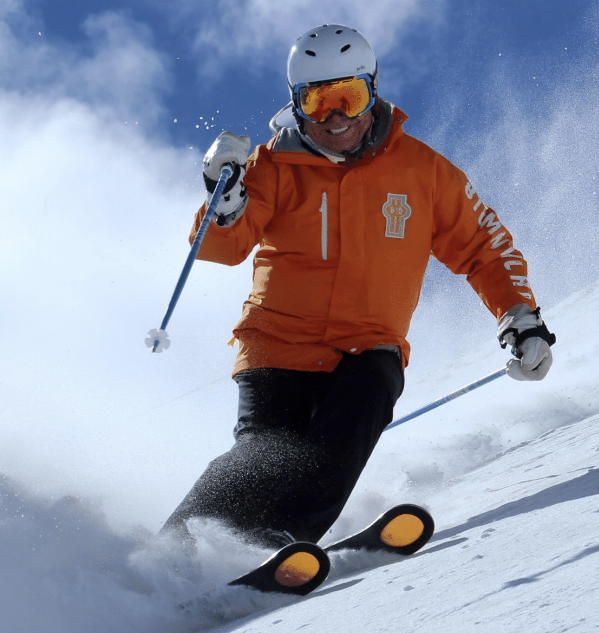It’s my business to sell the promise that a new pair of skis will bring joy and a sense of completion that life would lack without them. It grieves me to no end to inform you that while new skis may indeed augment your happiness and boost your self-esteem, the evidence suggests that they will not, in fact, make you a better skier.
Before I build up a head of steam, allow me to excuse all of you who have spent decades polishing your skills so you flow over any terrain with grace and artistry. The fulminations that follow are not for your ears, but for the vast herd of the oxymoronic “advanced intermediates” who count themselves as experts on groomers and dismiss their incompetence in bumps as unimportant.
Let’s first clear the air about what it means to be an expert. An expert is a terrain agnostic. An expert knows that to solve the inescapable equation Skiers + Snow = Moguls, one has to learn to navigate this natural formation. I saw this math in action a couple of days ago at Alpine Meadows, where a storm had deposited over a foot of unusually feathery powder on everything.
The trek up from Reno had been a biblical test of patience, so by the time I met up with wingman Rick Stalker, there wasn’t a shred of untouched snow anywhere. A small patch on the lower mountain had been groomed, as if to give intermediates hope, but the rest of this Tahoe playground was all bumps, all the time. Point being, if you don’t ski bumps, you’re missing out on a ton of great skiing – yes, Virginia, crud can be beautiful, too – and you’re also a few skills shy of actual expertise.
The ever-ebullient John Clendenin. The Clendenin Method focuses on the speed management skills needed to take your game off the groomers.
The main reason pseudo-experts eschew moguls is they expose flaws that aren’t so easily disguised. While some skis follow irregular terrain better than others, there are no skis that confer bump-ability just by wearing them. There’s no avoiding the fact that when in moguls, you have to move your damn feet. Moguls remind you that skiing is a sport, an athletic engagement that requires mind, body and soul to be all in. Moguls teach you to be present, aware and immersed in the moment.
Since skis by themselves won’t confer mogul mastery, the only way to achieve all-encompassing expertise is to take lessons.
I’ll pause for a moment while you stifle your gag reflex.
Americans tend to avoid lessons from all but the least qualified to provide them, such as relatives and friends. A note of caution to all who choose this path: your closest relations – a wife or husband, say – are not always the best teachers. No matter how intimate and loving you two may be under other circumstances, when a lesson goes wrong, poorly rendered advice results in recrimination, followed by more careless word choices, delivered at a higher pitch in order to drown out the crying.
I realize many Americans bypass formal instruction simply because it’s an incremental expense for an already account-draining activity. Others have arrived at a contented state of delusion about their skills and simply eliminate conditions that challenge them, ergo, no lessons required.
But in fact everyone can benefit from lessons. To make the exercise more palatable to the more experienced, let’s call it coaching instead of instruction. Coaching goes on at every level of every sport. Far from abandoning coaching as soon as marginal proficiency is achieved, participants in countless sports receive more coaching the better they get. The best in every field usually has more than one full-time coach.
Mike Rogan’s mastery of technique has landed him a teaching job with the US Ski Team as well as five elections to the PSIA Demo Team. For his tips on how to ski bumps, take a gander at this video.
Ponder this: Tiger Woods has a coach. If the greatest athlete ever to hold a club in his hands still thinks he can be better, chances are you’re missing an opportunity to raise your game, too.
I realize this exhortation has not removed the cost barrier to coaching. Tiger, after all, pays his support team. Yet there are some low-cost or no-cost opportunities for instruction at small feeder areas that are the grassroots of our sport. At Mt. Rose, for example, Reno locals preferred playground, instruction is free to seniors on Fridays. Often charity events, such as Pink Fest (sponsored by Bobo’s, among others), bundle instruction with a donation to a good cause.
If you’re an avid skier of means, there are a handful of teaching gurus who have developed unique methodologies for mastering certain aspects of our wildly diverse sport. Harald Harb has a comprehensive program for developing carving skills for never-evers through level-10 experts. Chris Fellows runs North American Ski Training & Climbing School (NASTC), focusing on mountaineering skills and big mountain skiing.
U.S. Ski and Snowboard Hall of Famer John Clendenin headlines camps conducted in Aspen and Portillo that apply Clendenin’s homegrown techniques for getting skiers off crowded groomers and into the well-moguled world that he calls, “the Kingdom.” It’s been my privilege to know JC for many years and I confess to being a big fan of his Clendenin Method. (Realskiers.com subscribers can see snippets of both JC’s program and Harb’s carving lessons on our members’ site. Certified PSIA members can get a free subscription to Realskiers for the asking. Drop me a line and I’ll hook you up.)
If you really want to savor all the mountains have to offer, treat yourself to a dose of coaching. Remember, even Tiger has a coach.

